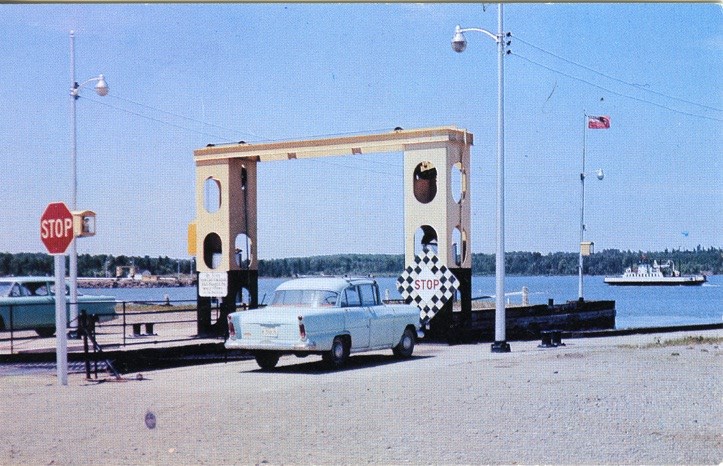From the archives of the Sault Ste. Marie Public Library:
*************************
Remember This . . . St. Joseph Island Ferry
Those visiting or living on St. Joseph Island today enjoy the ease of travelling back and forth by way of the bridge. However many will remember that a ferry was once the only way to travel back and forth for many years.
Ferry service was first established in 1919 when George Langstaff had a vision to build and begin operating a gasoline-powered ferry that ran on a 610-foot cable between Campement D’Ours and Kensington Point on the mainland. In 1922, Walter Lay built and operated another ferry called the 'Magic Carpet' linking St. Joseph Island to Pine Island. These ferries had a motor to propel them but they were not able to steer so they relied on the cable to go back and forth across the channel.
In 1934, the government took over both of these ferries and made free ferry service available to all users. These cable ferries were wooden, light cargo vessels and they were often severely battered by the ice conditions experienced in the early spring and late fall of each year.
In 1950, the Ontario Department of Highways made an announcement about a brand new diesel ferry that would finally provide the islanders with year-round ferry service. A naval architect was sent to the island in order to study the existing ferries and then make a recommendation on the design of the new ferry. The most important feature of the new ferry was the ice breaking capability so that for the first time islanders would be able to use the car ferry year round. The decision was made to move and shorten the route for the new ferry so that the crossing could be made in less time. The ferry would leave from Humbug Point on the mainland and travel 750 feet over to the island. This also meant that a new road would be constructed to connect the new ferry approach to Highway 17.
On December 24, 1952 the new St. Joseph Islander ferry finally went into service one week ahead of schedule. This ferry was built at a cost of $105,000. For the first week or so it operated on a 9 a.m. – 5 p.m. schedule until another crew was available to work the night shift. Newspaper accounts reported that most of the men who were qualified to run the ferry wanted to spend Christmas with their families and would not be available until after the New Year to form another crew in order to provide 24 hour service. The ferry crossing was now able to be completed in about three minutes. Once the new ferry was put into service the two previous ferries were taken out of service and the old ferry routes were abandoned.
The “Islander” ferry operated for twenty years and many people will remember the fun of watching the ferry make the crossing and patiently waiting for your turn to drive onto the ferry. Although the residents of St. Joseph Island appreciated the ferry service, they had been petitioning the government since the early 1900s for a bridge. Finally in May of 1971 work began on the construction of a bridge that would provide a permanent link between St. Joseph Island and the mainland. The bridge was opened to the public in December of 1972 with an official opening in the spring of 1973.
While the opening of the new bridge was exciting and represented a new chapter in the history of St. Joseph Island many feared for the future of the St. Joseph Islander ferry. However, this was not the end of the line for the car ferry. It was taken out of service and was transported to Prince Edward County to continue its life as a free car ferry. It was renamed the MV Glenora and has continued to provide a great service for those in Prince Edward County.
*************************
Each week, the Sault Ste. Marie Public Library and its Archives provides SooToday readers with a glimpse of the city’s past.
Find out more of what the Public Library has to offer at www.ssmpl.ca and look for more Remember This? columns here
